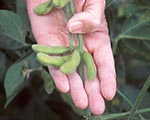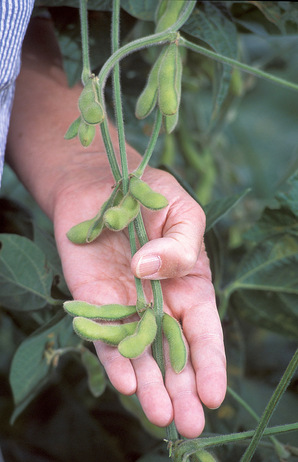« Innovation in Business Story
Complete Draft of the Soybean Genome
Breakthrough:The mapping and sequencing of the genetic code of soybean (Glycine max) paves the way for improved crops and advances in energy production.
Business:
HudsonAlpha Genome Sequencing Center plus another 17 research institutions, United States
The Story:
 Scientists have mapped out and sequenced the genome of the soybean, one of the world’s most important sources of protein and oil. It accounts for nearly three quarters of the planet’s edible protein, and is a promising feedstock for biodiesel production. The pioneering research opens the way for a whole raft of applications in agriculture and the biofuels industry.
Scientists have mapped out and sequenced the genome of the soybean, one of the world’s most important sources of protein and oil. It accounts for nearly three quarters of the planet’s edible protein, and is a promising feedstock for biodiesel production. The pioneering research opens the way for a whole raft of applications in agriculture and the biofuels industry.Collaborative Effort
A team consisting of 18 research institutions, including the U.S. Department of Energy Joint Genome Institute, and the U.S. Department of Agriculture took part, and soybean is the first major legume species to have a published draft genome sequence. According to scientists the plant has somewhere in the region of 46,000 genes.
The genome is essentially a microscopic biological kit of parts that took a little over three years to uncover and will tell scientists how the plant is put together and which genes are responsible for which characteristics, such as which are important for oil content or larger plants. This will help researchers to manipulate the genetic material to produce desired traits, and create new soy strains that could have major impacts on agriculture, the cost of food and how we travel. Scientists have already identified a genetic mutation that could be used to produce soybean crops that will make it easier for animals and humans to digest the protein-rich beans.
Major Benefits
Genetically modified characteristics may lead to: -
1) bigger crops
2) improved resistance to pests and diseases that destroy millions of hectares
of the crop each year
3) a boost in the plant’s oil content for food, and biodiesel – a cleaner
alternative to fossil fuels
“These genes and their associated pathways are the building blocks for soybean oil content and represent targets that can be modified to bolster output and lead to the increase of the use of soybean oil for biodiesel production,” said Gary Stacey, Professor of Soybean Biotechnology at the University of Missouri and co-author of the published paper on the genome research.
Speeding up Research Efforts
This draft genetic assembly is now freely available to researchers all over the world. Having the genetic code is going to change the face of soybean research as it will speed up discoveries in fundamental soybean biology. What used to take scientists years will now take just a few months, sometimes even a few weeks. In addition, as the genetic information is in the public domain every plant breeder can look for sequences that will help speed up the breeding process.
Spilling the Beans
One of the next steps will be to compare the draft sequence with more than 20,000 soybean lines to look for any desirable gene variants that are no longer found in crops currently grown. When soybeans were originally domesticated they were selected for traits such as seed size, but scientists believe that genes for many other valuable qualities could’ve been left behind, such as those for protein content or disease resistance. If discovered, these could be incorporated into germlines to provide a host of new benefits.
Next Story »
IdeaConnection: What Can we Solve for You?

